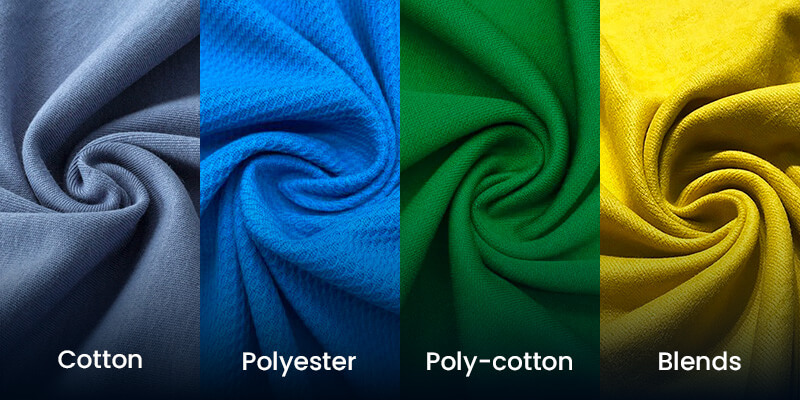When it comes to purchasing clothing, there is an overwhelming variety of fabric options available. From cotton to polyester, blends, and tri-blends, it can be challenging to decide which fabrics are the right choice for you. In this article, we will explore popular fabrics and their unique features, helping you make an informed decision.
Cotton: A Timeless Fabric
Let’s begin with cotton, a fabric that has stood the test of time. Known as “the fabric of our life,” cotton remains a popular choice for clothing.
Cotton offers numerous advantages. Firstly, it is known for its softness and comfort, providing a pleasant sensation against the skin. Additionally, cotton is highly breathable, allowing air to circulate and keeping you cool. It also has excellent moisture-wicking properties, making it suitable for activities that may cause sweating or hot climates. Moreover, cotton is hypoallergenic and gentle on sensitive skin.
However, cotton does have a few drawbacks. It is prone to shrinkage, so it is important to follow proper care instructions to maintain its size. Cotton also tends to fade faster compared to synthetic fabrics and wrinkles easily. Additionally, cotton takes longer to dry than synthetic materials.
Types of Cotton
Not all cotton fabrics are the same. Cotton is made by spinning fibers from cotton plant pods, and different manufacturing processes can result in various types of fabric.
Ring-spun cotton is a type of cotton that undergoes continuous twisting, softening, and straightening of the fibers in one direction. This process produces a yarn that is softer, stronger, and more breathable.
Combed ring-spun cotton goes through the same process as regular ring-spun cotton but with an additional step of combing to remove impurities. This results in an even softer fabric with a smoother surface, ideal for printing on.
Polyester: The Durable Synthetic Fabric
Polyester, a synthetic fabric derived from petroleum, gained popularity in the 1970s due to its affordability and durability, earning it the nickname “miracle fabric.” It is widely used in various wholesale blank apparel items such as t-shirts, polos, and jackets. Although there are environmental concerns associated with polyester, the use of recycled plastics, including plastic water bottles, has made it more sustainable.
Polyester offers several advantages. It is highly durable, making it resistant to wear and tear. Polyester is also moisture-wicking, drawing moisture away from the body and keeping you dry and comfortable. Moreover, polyester is lightweight, making it suitable for breathable and lightweight garments. It is also resistant to shrinking and wrinkling, allowing the fabric to maintain its shape and appearance.
However, polyester has a few downsides. It has lower breathability compared to natural fibers, which may result in a less comfortable wearing experience, particularly in hot and humid conditions. Polyester may not be the best choice for those with sensitive skin, as it may cause irritation or discomfort. Additionally, polyester is heat-sensitive, requiring caution when heat-pressing garments made from this fabric.
Poly-cotton Blends: The Best of Both Worlds
If you find it challenging to choose between the softness of cotton and the durability of polyester, a poly-cotton blend might be the perfect solution.
Poly-cotton blends combine the advantages of both fabrics. They offer apparel that is almost as soft and breathable as 100% cotton while providing the moisture-wicking and fast-drying properties of 100% polyester. Most poly-cotton blends indicate a specific fabric ratio, such as 50/50 or 60/40. Blends with more cotton than polyester are known as CVC (Chief Value Cotton) blends.
However, there are a few considerations. The polyester content in the blend might cause allergies in some individuals, so it’s crucial to be mindful of any sensitivities. Poly-cotton blends tend to be more expensive than pure polyester or cotton options. Additionally, there may be minor restrictions on printing options when working with poly-cotton blends.
Tri-blends: Combining Three Materials
Tri-blends are fabrics made by blending three different materials, typically cotton, polyester, and rayon, a synthetic fiber. The polyester content is usually around 50%, with varying ratios of the other two materials.
Tri-blends offer unique advantages. They are notably softer than other fabrics due to the addition of rayon. Tri-blends also provide excellent durability, ensuring the longevity of the garment
However, there is one significant consideration: tri-blends can be more expensive than other fabric options. The luxurious feel and enhanced durability come at a higher price point.
Other Fabrics to Consider
- Fleece: A lightweight yet dense fabric that provides warmth without adding bulk. It is often used as an inner lining in outerwear and is versatile for various weather conditions.
- Spandex: A stretchable fabric often blended with other fibers to add elasticity, making it ideal for clothing requiring mobility, such as fitness apparel.
- Acrylic: A synthetic fabric that off
With a better understanding of the different fabric options available, you can now make an informed decision when selecting apparel that suits your needs and preferences.

